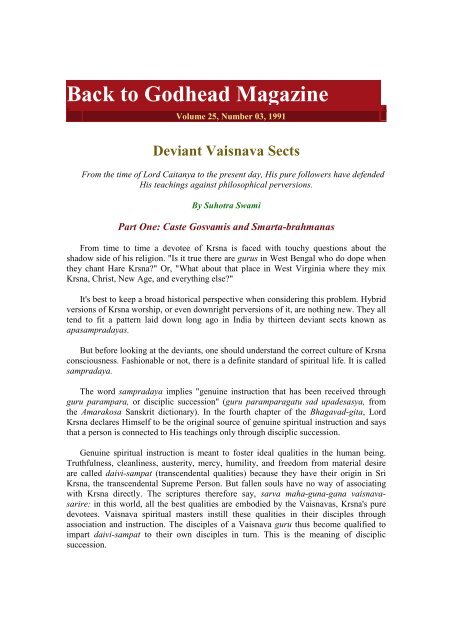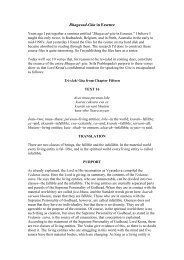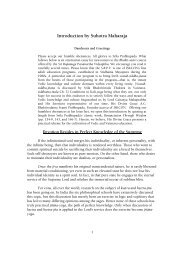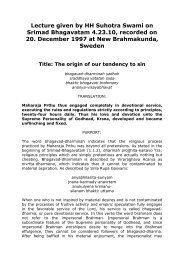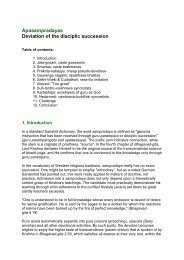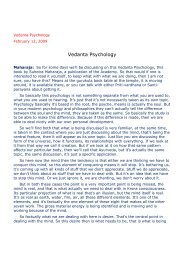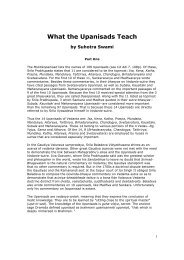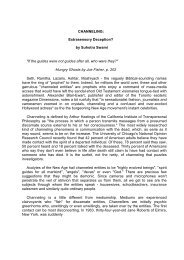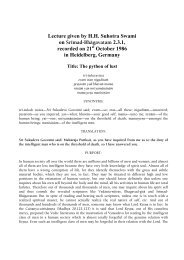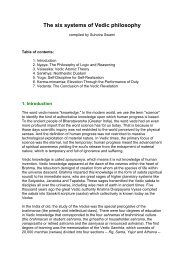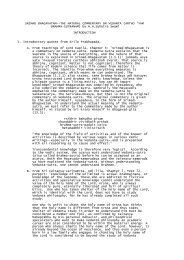Deviant Vaisnava Sects - Suhotra Maharaja Archives
Deviant Vaisnava Sects - Suhotra Maharaja Archives
Deviant Vaisnava Sects - Suhotra Maharaja Archives
You also want an ePaper? Increase the reach of your titles
YUMPU automatically turns print PDFs into web optimized ePapers that Google loves.
Back to Godhead Magazine<br />
Volume 25, Number 03, 1991<br />
<strong>Deviant</strong> <strong>Vaisnava</strong> <strong>Sects</strong><br />
From the time of Lord Caitanya to the present day, His pure followers have defended<br />
His teachings against philosophical perversions.<br />
By <strong>Suhotra</strong> Swami<br />
Part One: Caste Gosvamis and Smarta-brahmanas<br />
From time to time a devotee of Krsna is faced with touchy questions about the<br />
shadow side of his religion. "Is it true there are gurus in West Bengal who do dope when<br />
they chant Hare Krsna?" Or, "What about that place in West Virginia where they mix<br />
Krsna, Christ, New Age, and everything else?"<br />
It's best to keep a broad historical perspective when considering this problem. Hybrid<br />
versions of Krsna worship, or even downright perversions of it, are nothing new. They all<br />
tend to fit a pattern laid down long ago in India by thirteen deviant sects known as<br />
apasampradayas.<br />
But before looking at the deviants, one should understand the correct culture of Krsna<br />
consciousness. Fashionable or not, there is a definite standard of spiritual life. It is called<br />
sampradaya.<br />
The word sampradaya implies "genuine instruction that has been received through<br />
guru parampara, or disciplic succession" (guru paramparagatu sad upadesasya, from<br />
the Amarakosa Sanskrit dictionary). In the fourth chapter of the Bhagavad-gita, Lord<br />
Krsna declares Himself to be the original source of genuine spiritual instruction and says<br />
that a person is connected to His teachings only through disciplic succession.<br />
Genuine spiritual instruction is meant to foster ideal qualities in the human being.<br />
Truthfulness, cleanliness, austerity, mercy, humility, and freedom from material desire<br />
are called daivi-sampat (transcendental qualities) because they have their origin in Sri<br />
Krsna, the transcendental Supreme Person. But fallen souls have no way of associating<br />
with Krsna directly. The scriptures therefore say, sarva maha-guna-gana vaisnavasarire:<br />
in this world, all the best qualities are embodied by the <strong>Vaisnava</strong>s, Krsna's pure<br />
devotees. <strong>Vaisnava</strong> spiritual masters instill these qualities in their disciples through<br />
association and instruction. The disciples of a <strong>Vaisnava</strong> guru thus become qualified to<br />
impart daivi-sampat to their own disciples in turn. This is the meaning of disciplic<br />
succession.
In Kali-yuga, the present age, there are only four genuine sampradayas wherein<br />
saintly <strong>Vaisnava</strong> association can be found. One of these is the Brahma Sampradaya,<br />
established in South India by the great acarya Madhva. This sampradaya was accepted<br />
by Sri Caitanya Mahaprabhu when He received initiation into the chanting of the Hare<br />
Krsna maha-mantra from His guru, Sri Isvara Puri. Then, in Bengal (Gaudadesa), Lord<br />
Caitanya began His movement of sankirtana, the congregational chanting of the holy<br />
names of Krsna. Lord Caitanya's sankirtana mission, of which the International Society<br />
for Krishna Consciousness is the worldwide exponent, is known as the Brahma-Madhva-<br />
Gaudiya Sampradaya.<br />
Srila Bhaktivinoda Thakura has identified thirteen apasampradayas that claim to<br />
have inherited Lord Caitanya's mission, though they have nothing to do with the Brahma-<br />
Madhva-Gaudiya Sampradaya. They are known by the names aula, baula, kartabhaja,<br />
neda, daravesa, sani, sahajiya, sakhibheki, smarta, jata-gosani, ativadi, cudadhari, and<br />
gauranga-nagari. Because these apasampradayas (apa means "deviated") do not nurture<br />
<strong>Vaisnava</strong> qualities, their missionary activities are condemned as cheating.<br />
As mentioned in <strong>Vaisnava</strong> Ke, by Srila Bhaktisiddhanta Sarasvati, the<br />
apasampradayas display only inauspicious qualities. One is anitya-vaibhava, the<br />
hankering for material success. Another is kaminira-kama, illicit sexual affairs that are<br />
usually passed off as "transcendental." And a third is maya-vada, philosophical<br />
speculation that undercuts the personal nature of God as taught by the <strong>Vaisnava</strong><br />
sampradayas.<br />
What follows is an in-depth look at the deviations of each of the thirteen<br />
apasampradayas. In this article's first installment, two of the most important, the jatagosani<br />
and the smarta, are dealt with.<br />
Caste Gosvamis<br />
The word jata means "by birth" or "by family." Gosani is a Bengali form of the<br />
Sanskrit word gosvami, which means "one who controls his senses." The word jatagosani<br />
is used in a critical sense to refer to those who take the position of gurus only on<br />
the basis of heredity, without having the required spiritual qualifications as well. The<br />
point here is that it is not enough to claim family connections to associates of Sri<br />
Caitanya Mahaprabhu. One must be a pure devotee of the Lord.<br />
The devotees in the Gaudiya <strong>Vaisnava</strong> sampradaya, follow the original six Gosvamis<br />
of Vrndavana. These six devotees, who were all in the renounced order of life, were most<br />
illustrious disciples of Sri Caitanya Mahaprabhu. About these Gosvamis Srinivasa<br />
Acarya has written:<br />
The six Gosvamis—Sri Rupa, Sri Sanatana, Sri Raghunatha<br />
Bhatta, Sri Raghunatha Dasa, Sri Jiva, and Sri Gopala Bhatta—<br />
are worshipable because they renounced their aristocratic family<br />
life as insignificant and became mendicants to preach and
deliver the fallen souls. They are always bathing in the waves of<br />
ecstatic love for Krsna.<br />
Thus the six Gosvamis set the ideal example of pure devotional service.<br />
To follow in the footsteps of the six Gosvamis, one must strictly follow the rules and<br />
regulations of devotional service, as explained by Srila Rupa Gosvami in his Bhaktirasamrta-sindhu<br />
(The Nectar of Devotion).<br />
Sometimes, however, persons who neglect these devotional principles claim to be<br />
gosvamis simply on the basis of heredity. They have inherited the name Gosvami but not<br />
the consciousness of a gosvami.<br />
Without proper devotional training, such jata-gosanis, or caste gosvamis, disregard<br />
the regulative principles, neglect the devotional service of the Lord, and use the temple as<br />
a place for their own family comforts.<br />
As Srila Bhaktisiddhanta Sarasvati used to say, such untrained persons use the<br />
worshipable form of the Lord as "stones for cracking nuts" (that is, as a means of income<br />
for sense enjoyment).<br />
On the other hand, in India there are still families that are learned and devoted by<br />
tradition and training. They strictly follow regulative principles, they render excellent<br />
service to the Lord, and they foster Krsna conscious devotional service generation after<br />
generation.<br />
Those born in such gosvami families have the fortunate opportunity to serve the Lord,<br />
and when properly trained they may also become pure devotees. They are then to be<br />
accepted as gosvami not only in name but in fact.<br />
The essential consideration, therefore, is pure devotional service. Whether born in a<br />
high family or a low family, anyone, from any part of the world, can become a pure<br />
devotee of the Lord. As stated by Sri Caitanya Mahaprabhu:<br />
kiba vipra, kiba nyasi, sudra kene naya<br />
yei krsna-tattva-vetta, sei 'guru' haya<br />
The pure devotee is one who knows the science of Krsna and follows its principles.<br />
Such a person can be accepted as a bona fide spiritual master.<br />
What is objectionable, therefore, is the claim that pure devotional service can be<br />
performed or spread only by a particular caste or clan. This idea is contrary to Lord<br />
Caitanya's teachings.<br />
An example of such a clan is the so-called Nityananda Vamsa, who claim to descend<br />
from three grandsons of Lord Caitanya's great associate Lord Nityananda. The members
of the Nityananda Vamsa sometimes say that Lord Nityananda's divine essence is carried<br />
in their family blood line.<br />
This is mendacious on two counts. First, the ancestors of the Nityananda Vamsa were<br />
actually disciples, not sons, of Lord Nityananda's only and childless son, Sri Virabhadra<br />
Gosvami. Second, a person is known to be a <strong>Vaisnava</strong> not by birth from a particular<br />
womb but by his character.<br />
Up until the early part of this century, the Nityananda Vamsa held the lower-caste<br />
<strong>Vaisnava</strong>s in a thrall of superstition and wrong teachings.<br />
But beginning in the late 1800's, Srila Bhaktivinoda Thakura challenged them in his<br />
popular Bengali-language books like Jaiva Dharma and Hari Nama Cintamani. He<br />
proclaimed that it is not enough to accept a spiritual master merely on the basis of caste.<br />
Before taking initiation, the candidate must be sure that the initiator is fully conversant<br />
with the scriptures and can lift his disciples out of ignorance. The guru should be of<br />
spotless character: if he is addicted to sinful acts, then even those he may have already<br />
initiated must reject him.<br />
Bhaktivinoda's books unleashed a wave of reform in Bengal that pushed the jatagosani<br />
into a defensive stance. But the confrontation came to open war when his son,<br />
Srila Bhaktisiddhanta Sarasvati, took over the Gaudiya mission.<br />
Srila Bhaktisiddhanta Sarasvati publicly smashed the arguments placed before him by<br />
those who held that devotional service was a monopoly of their own caste. Such ideas, he<br />
said, were products of "skin disease."<br />
The basic misunderstanding in materialistic life is that the body is the self. Under<br />
illusion, one thinks of oneself as American, British, or Indian, young or old, man or<br />
woman, white or black. In fact, however, these are merely bodily designations, labels for<br />
the skin. And so too are designations of family and caste. To take birth in a high family<br />
may offer one an opportunity to become Krsna conscious. But the birth itself is not an<br />
automatic guarantee. Nor does birth in a low family exclude one. Anyone who performs<br />
pure devotional service to the Lord, regardless of jati, or birth, becomes a member of the<br />
transcendental family of Lord Sri Krsna. This is Lord Caitanya's teaching.<br />
Smarta-brahmanas<br />
The Padma Purana, a text of Vedic teachings, states that if we always remember<br />
Visnu or Krsna (smartavyah satatam visnoh) before performing our duty, we<br />
automatically fulfill all scriptural rules and regulations. If we forget Him, we unavoidably<br />
transgress the spirit of the scriptures even if we observe them to the letter, because<br />
keeping Krsna always in mind is the purpose of all the scriptural codes of behavior.<br />
Not everyone admits that purpose. There are three classes of brahmanas: the dvija,<br />
the vipra, and the <strong>Vaisnava</strong>. The third-class dvija is ritualistically initiated, the second-
class vipra is learned in the Vedas, and the first-class <strong>Vaisnava</strong> knows that the goal of the<br />
Vedas is to always remember Krsna and never forget Him. A dvija or vipra who is not a<br />
devotee can't know the real sense of the rules and regulations of scripture; like a crooked<br />
lawyer, he'll use the law to enrich himself materially. The nondevotee dvija or vipra is<br />
what is meant by the term smarta-brahmana.<br />
Smarta-brahmanas totally reverse the instruction of the Padma Purana: rather than<br />
always remember Krsna and thus fulfill the rules and regulations, they remember the<br />
rules and regulations and always forget Krsna. The acara (behavior) of a strict smartabrahmana<br />
and a strict <strong>Vaisnava</strong> may externally be almost the same, but the consciousness<br />
is completely different.<br />
In its subtlest form, the smarta contamination is a shift of values more than of<br />
behavior or even philosophy. Smarta values are called purusarthika, whereas <strong>Vaisnava</strong><br />
values are paramapurusarthika. The difference between the two is explained by Srila<br />
Prabhupada in the Caitanya-caritamrta (Antya 7.24, Purport):<br />
Purusartha ("the goal of life") generally refers to religion,<br />
economic development, satisfaction of the senses, and, finally,<br />
liberation. However, above these four kinds of purusarthas, love<br />
of Godhead stands supreme. It is called paramapurusartha (the<br />
supreme goal of life) or purusartha-siromani (the most exalted<br />
of all purusarthas).<br />
Smarta-brahmanas think that one must be born in the brahmana caste to be a guru.<br />
But according to Lord Caitanya, a person from any family, race, color, or creed can be<br />
guru as long as he or she knows the spiritual science of Krsna consciousness.<br />
The smartas also claim the exclusive birthright to worship the salagrama-sila (Lord<br />
Visnu's form as a black stone, which may be worshiped only by qualified brahmanas).<br />
And they never marry outside of the brahmana caste—this taboo is followed so rigidly<br />
that a smarta father would rather give his daughter to the son of a priest of the tantric<br />
school (which uses black rituals and offerings of meat and wine) than to a non-brahmana<br />
<strong>Vaisnava</strong>.<br />
The smartas then, are afflicted by upper-caste pride. But although the jata-gosanis<br />
who overemphasize birthright may also be afflicted by pride, the two communities differ<br />
in their mode of worship. Caste gosvamis are exclusively priests of Krsna temples;<br />
ritualistically, at least, they are <strong>Vaisnava</strong> brahmanas. Caste brahmanas, on the other<br />
hand, worship according to the Mayavadi pancopasana conception. Thus they regard<br />
Lord Krsna or Visnu to be one of five forms of Brahman. Of the five (Durga, Ganesa,<br />
Surya, Siva, and Visnu), Bengali smartas have always preferred goddess Durga because<br />
she supplies her devotees with material opulence.<br />
In the fifteenth and sixteenth centuries A.D., the importance of the Bengali smarta<br />
community was practically nullified by Lord Caitanya's sankirtana movement. Among
the great <strong>Vaisnava</strong> acaryas of that period, Srila Narottama Dasa Thakura stands out as<br />
the preacher who most cut down their pride.<br />
The smartas, considering Narottama just a low-born kayastha (the clerical caste in<br />
Bengal), became so infuriated at his making disciples from among their ranks that they<br />
enlisted the king, Raja Narasimha, and a conquering pandita named Sri Rupa Narayana<br />
to lead a crusade to somehow expose Acarya Thakura as a fraud. The king, the pandita,<br />
and a large party of caste brahmanas made their way to Kheturi, where Srila Narottama<br />
Dasa had his headquarters.<br />
When Sri Ramakrsna Bhattacarya and Sri Ganga Narayana Cakravarti, two <strong>Vaisnava</strong><br />
brahmanas, came to know of the smarta conspiracy, they disguised themselves as sudras<br />
and set up two small shops in the Kumarapura market: one a pan and betel nut shop and<br />
the other a store selling clay pots.<br />
As the party arrived at Kumarapura, the smartas sent their disciples to the market to<br />
purchase wares for cooking. When the students came to the shops of Ramakrsna and<br />
Ganga Narayana, they were dumfounded to find that these merchants spoke perfect<br />
Sanskrit and were eager not to do business but to engage in philosophical disputation.<br />
Finding themselves outmatched, the distressed students called for their gurus, who<br />
arrived on the scene with Raja Narasimha and Rupa Narayana. When the smartas fared<br />
no better than their disciples, Rupa Narayana himself was drawn into the debate and was<br />
soundly defeated.<br />
The king demanded they introduce themselves. The two shopkeepers humbly<br />
submitted that they were low-born and insignificant disciples of Srila Narottama Dasa<br />
Thakura Mahasaya. Shamed, Rupa Narayana and the smarta-brahmanas lost interest in<br />
proceeding to Kheturi. They returned immediately to their respective homes.<br />
That night, Raja Narasimha had a dream in which an angry Durga Devi threatened<br />
him with a chopper used for killing goats. Glaring at him with blazing eyes, the goddess<br />
said, "Narasimha! Because you greatly offended Narottama Dasa Thakura, I shall have to<br />
cut you to pieces! If you want to save yourself, then you had better immediately go and<br />
take shelter at his lotus feet."<br />
His sleep broken, the frightened king quickly bathed and set out for Kheturi. Arriving<br />
there at last, he was surprised to meet the pandita Rupa Narayana, who sheepishly<br />
explained that he'd had a similar dream. They went to the temple of Sri Gauranga to meet<br />
Srila Narottama Dasa Thakura.<br />
Acarya Thakura was absorbed in his devotions, but when a disciple informed him of<br />
the arrival of the two guests, he came out to meet them. Simply by seeing his<br />
transcendental form, the two offenders became purified and fell down to offer their<br />
obeisances at the Thakura's lotus feet. Finally he initiated them with the Radha-Krsna<br />
mantra.
Because their leaders had become <strong>Vaisnava</strong>s, many lesser smartas thought it<br />
fashionable to externally adopt <strong>Vaisnava</strong> customs. This is how the smarta<br />
apasampradaya, or Vaisnavism compromised by caste brahmanism, began.<br />
In the late nineteenth century a well-known member of this community claimed to be<br />
the incarnation of Rama, Krsna, and Sri Caitanya Mahaprabhu. He established a<br />
missionary movement that preached the worship of Kali-Krsna, a concocted deity<br />
blending the forms of goddess Kali and Sri Krsna.<br />
Srila Bhaktisiddhanta Sarasvati Thakura soundly defeated the smarta apasampradaya<br />
at the town of Valighai Uddharanapura, West Bengal, in September 1911. He presented a<br />
work in which he conclusively argued the superiority of <strong>Vaisnava</strong>s to brahmanas. He<br />
read the paper before a gathering of more than ten thousand panditas, and though he was<br />
the youngest speaker present, the judges acclaimed Srila Bhaktisiddhanta Sarasvati the<br />
winner of the dispute.<br />
Nowadays, the smarta-brahmana community of Bengal has largely succumbed to<br />
secularism and exerts little influence in spiritual affairs.<br />
<strong>Suhotra</strong> Swami, an American disciple of Srila Prabhupada, has taught Krsna<br />
consciousness in Europe since the mid-seventies. He was recently appointed ISKCON's<br />
Governing Body Commissioner for Poland, Bulgaria, Romania, Albania, and<br />
Czechoslovakia.<br />
Back to Godhead Magazine<br />
Volume 25, Number 04, 1991<br />
<strong>Deviant</strong> <strong>Vaisnava</strong> <strong>Sects</strong><br />
Some who say they follow<br />
Lord Caitanya try to make His easy method easier—<br />
by throwing out the rules.<br />
By <strong>Suhotra</strong> Swami<br />
Part Two: Prakrta-sahajiyas<br />
The great spiritual master Srila Bhaktivinoda Thakura spoke of thirteen sects that<br />
claim to have inherited Lord Caitanya's mission but who distort His teachings. Although<br />
especially prominent in Bengal, their ideas show up even in the West. Here, therefore, in<br />
the second of a three-part series, <strong>Suhotra</strong> Swami continues to examine these sects.
VAISNAVAS, devotees of Lord Krsna, use the term prakrta-sahajiya to refer to<br />
persons who imitate the signs of prema, pure love for God, while still addicted to the<br />
low-class pleasures of illicit sex and intoxication. The sahajiyas imagine that they feel the<br />
divine emotions of Krsna and His dearest devotee, Srimati Radharani. Yet they don't<br />
understand that before we can savor the pleasure shared by Radha and Krsna, we must rid<br />
ourselves of lustful desires for sensual pleasure.<br />
The word sahaja means "easy." A prakrta-sahajiya wants the bliss of spiritual life<br />
without the struggle to attain it. And the word prakrta means "materialistic." Because the<br />
sahajiyas forgo the standard disciplines of bhakti-yoga, the divine love they apparently<br />
show never gets beyond material lust.<br />
The prakrta-sahajiyas mistake lust—the disease of the soul—for spiritual<br />
advancement. So instead of curing lust, they wind up cultivating it.<br />
Bhagavad-gita (16.23-24) recommends that we follow sastra-vidhi, the directions of<br />
the scriptures, to purify ourselves of lust. Sastra-vidhi especially calls for us to give up<br />
meat-eating, illicit sex, gambling, and intoxication and to chant the Hare Krsna mahamantra.<br />
This gradually readies us for raga-marga, the path of natural attraction to Krsna,<br />
reserved for highly advanced devotees.<br />
The prakrta-sahajiyas, however, go easy on the scriptural regulations. They stay<br />
attached to materialistic enjoyment of the senses. But this sense enjoyment blinds them,<br />
and therefore their ideas of Krsna, Krsna's devotees, Krsna's service, and love of Krsna<br />
are but a faulty creation of their lower nature.<br />
According to the Bengali historian Dr. S. B. Das Gupta, the Bengali sahajiya<br />
movement can be traced back long before the time of Sri Caitanya Mahaprabhu, to the<br />
reign of the Buddhist Pala dynasty (c. A.D. 700-1100). At that time a secret cult of the<br />
name Sahajayana arose within the Vajrayana ("Diamond Vehicle") school of Buddhism.<br />
Sahajayana Buddhists abandoned ritualism and study of scriptures as useless. They<br />
practiced a "yoga of sex" in which they took consciousness to be the unity of the male<br />
and female principles, sometimes called upaya and prajna, or karuna and sunyata. The<br />
Sahajayana Buddhists wrote many songs, known as the Caryapadas, expressing their<br />
philosophy in mysterious language.<br />
Later, under the Sena kings, Vaisnavism became ascendant in Bengal when the great<br />
spiritual master Jayadeva Gosvami won royal patronage for it. The Buddhist sahajiyas<br />
then absorbed aspects of <strong>Vaisnava</strong> philosophy and twisted them. They renamed their<br />
upaya and prajna principles "Krsna" and "Radha," imagining Radha-Krsna to represent<br />
the highest state of bliss attained by men and women on the sahajiya path.<br />
In the thirteenth century, with the Islamic occupation of northern India and Bengal,<br />
the sahajiyas were influenced by the practices and philosophy of the Sufis. The word sufi<br />
comes from the Arabic word saf, meaning "sacred," and it signifies a mystical Islamic
order of mendicants. Their goal is a state of inspiration called fana, or oneness in love<br />
with Allah.<br />
Sufis seek to attain fana through song and dance. In the Middle Ages they faced<br />
persecution as heretics in Arabic countries, especially because some Sufi preachers<br />
announced that they were themselves the very Allah worshiped by all Muslims. But in<br />
India the Sufis could flourish, not in the least because their ideas had much in common<br />
with Mayavada, or impersonalistic, philosophy.<br />
The sixteenth century saw the advent of Sri Caitanya Mahaprabhu and His movement<br />
of sankirtana, congregational chanting of the holy names of God.<br />
In a typical social blur, the sahajiyas who had arisen from the Buddhists and merged<br />
with the Sufis now sang and danced on the fringes of the sankirtana movement. There<br />
they celebrated their mundane sexual mysticism with song and dance.<br />
This, of course, was a perversion of the sankirtana movement. So Lord Caitanya and<br />
His followers rejected the sahajiyas. This is evident in Sri Caitanya-caritamrta, which<br />
tells us how strictly Lord Caitanya followed the rules of celibacy and how sternly He<br />
dealt with those devotees who broke them.<br />
By the 1700's, however, the great movement begun by Lord Caitanya appeared to<br />
have become corrupted by the caste gosvamis and the ritualistic smarta brahmanas [see<br />
the May/June issue of BTG]. This offered a chance for the sahajiyas to influence the<br />
common people, and various prakrta-sahajiya sects became popular.<br />
In the next century, therefore, Srila Bhaktivinoda Thakura took pains to distinguish<br />
the pure teachings of Lord Caitanya from prakrta-sahajiya perversions. Following his<br />
example, Srila Bhaktisiddhanta Sarasvati strongly opposed those who deviated from Lord<br />
Caitanya's teachings. And Srila Prabhupada kept to this same strong, uncompromising<br />
course.<br />
As Srila Prabhupada mentions in his commentary on Caitanya-caritamrta, the<br />
sahajiyas "indulge in sense gratification in the name of devotional service." In this way<br />
they "throw mud into transcendence." They churn their materialistic emotions into a state<br />
of sentimental ecstasy, and this they take to be spiritual. But the first step in spiritual<br />
advancement is to distinguish between spirit and matter. The sahajiyas confuse the two.<br />
"The name of Krsna is all-powerful," the sahajiyas say. "So the spiritual state of a<br />
guru and disciple at initiation doesn't matter, because the holy name works by its own<br />
power. There's no need to tell anyone to follow rules—let them chant Hare Krsna, smoke,<br />
drink, gamble, and have sex. The holy name will cleanse them of sinful reactions."<br />
Genuine spiritual masters reject such notions as offenses to the holy name of Krsna.<br />
The holy name of the Lord is certainly all-powerful, just as a fire is powerful. But fire can<br />
give life, and fire can kill. So too, the holy name of Krsna, properly chanted under the
guidance of a spiritual master, burns up the devotee's lingering material attachments. It<br />
nourishes his spiritual life. But if the power of the holy name is used as a tool to mix<br />
spiritual life with intoxication and illicit sex, the effect is ruinous.<br />
Another feature of the sahajiya attitude is its perverse "humility" (really just envy).<br />
The sahajiyas consider themselves simple and modest and the strict devotees haughty.<br />
For example, sahajiyas think that a devotee who becomes known for spreading Krsna<br />
consciousness has fallen into the grip of name and fame. A devotee who refutes atheists<br />
and materialists is proud. Congregational singing of the Lord's holy names is showy.<br />
Devotees fussy about giving up illicit sex, smoking, and other harmless enjoyments are<br />
fanatical and inwardly attached to these pleasures.<br />
Sahajiyas look down on devotees who take disciples and train them in scriptural<br />
principles. The scriptures, the sahajiyas think, oppose true devotion. So the sahajiyas<br />
either interpret the scriptures in their own way or write new scriptures to prove that sex<br />
and intoxication promote rather than obstruct spiritual awareness.<br />
In summary, prakrta-sahajiyas are stubborn sense enjoyers. They may have talents<br />
for singing, dancing, acting, speaking, joking, and seducing women or men. They may try<br />
to pass off these talents as spiritual accomplishments. And they may dress as Krsna<br />
conscious devotees. But in fact they can't see the difference between offensive and pure<br />
chanting of the holy name. They take worldly service to be devotional service, lust to be<br />
love, and illusion to be spirituality.<br />
Gauranga Nagaris<br />
The gauranga nagaris are a type of sahajiya who mix moods of devotion (rasas) in a<br />
clashing, unpalatable way. This error is technically called rasabhasa. The gauranga<br />
nagaris are prominent in Bengal and Bangladesh.<br />
Some of their customs seem praiseworthy. For example, like staunch <strong>Vaisnava</strong>s they<br />
wear tilaka and neckbeads, perform good kirtana, and strictly abstain from flesh and fish.<br />
But they are counted out of Lord Caitanya's disciplic line because of a subtle<br />
contamination in their idea of who Lord Caitanya is.<br />
The gauranga-nagaris are devotees of Lord Caitanya, who is also known as<br />
Gauranga ("the golden-limbed Lord"). But they impose upon Him Krsna's role as the free<br />
enjoyer of the village girls of Vrndavana. They style Him as nagara (a lusty village<br />
youth) and themselves as nagari (village girls).<br />
Yet although it is true that Lord Caitanya is Krsna Himself, His mood is never that of<br />
Krsna, the supreme enjoyer, but always that of Krsna's devotee.<br />
In the Caitanya-caritamrta (Adi 1.5), Lord Gauranga is said to be golden because He<br />
is radha-bhava-dyuti-suvalita, "adorned with the mood and luster of Srimati Radharani,"
Krsna's foremost devotee. Nowhere in any revealed scripture is it said that Lord Caitanya<br />
descends with the mood of Krsna.<br />
Spokesmen for the gauranga-nagaris not only say that Lord Caitanya exhibited<br />
Krsna's enjoying mood; they say that Visnupriya Devi, the Lord's second wife, was<br />
Srimati Radharani and that her close female friends were gopis.<br />
But as Srila Vrndavana dasa Thakura makes clear in Sri Caitanya Bhagavata,<br />
Visnupriya Devi is actually a form of the goddess of fortune, Laksmi. The wives,<br />
mothers, and daughters of Lord Caitanya's associates attended Visnupriya just as the<br />
maidservants of Laksmi serve Laksmi in the spiritual world. They serve in awe and<br />
reverence, not in the informal mood of the gopis.<br />
Sri Caitanya Bhagavata also speaks clearly about Sri Caitanya Mahaprabhu's extreme<br />
gravity in His dealings with women—even with His own wives, what to speak of other<br />
women. But the gauranga nagaris have invented offensive myths about Lord Caitanya's<br />
supposed love affairs. These stories should never be heard.<br />
The so-called mood of devotion of the gauranga nagaris is mere eroticism. Their<br />
conception of Lord Gauranga is a creation of their impure minds, and as they meditate<br />
upon this wrong conception, they succumb to lust. But, following the sahajiya line, they<br />
take that lust to be spiritual ecstasy.<br />
Sakhi Bekhi and Cuda Dhari<br />
Sakhi is a term for the confidential girlfriends of Srimati Radharani. The word bekhi<br />
is a corruption of the Sanskrit word vesa, which means "dress." A sakhi bekhi is a man or<br />
a woman who dresses like a gopi and imagines himself or herself to be enjoyed by Krsna.<br />
Sakhi bekhis imitate rasa-lila, Krsna's dance with the gopis, sometimes by dancing<br />
with a person dressed like Krsna who wears a cuda, a crown of peacock feathers. This<br />
person is called cuda dhari. The philosophy of these two types of sahajiya groups is the<br />
same. Practically the only difference is that one group dresses like gopis and the other<br />
like Krsna.<br />
Lord Caitanya taught, "The only controller is Krsna; everyone else is His servant."<br />
Each spirit soul is a tiny spark of para-prakrti, the Lord's subordinate or female spiritual<br />
energy. But this sense of our "being female" has nothing to do with mundane gender. We<br />
have temporarily assumed a male or female body as a result of past karma; the material<br />
covering does not reflect the eternal nature of the soul.<br />
From Srimad-Bhagavatam (Canto 4, Chapter 28) we learn that souls now in men's<br />
bodies received them as a karmic result of earlier lives when they were women with a<br />
lusty attachment to men. And those now in women's bodies were men too attached to<br />
women.
The soul as a spiritual spark caught in the cycle of birth and death is genderless. But<br />
according to the particular ecstasy a soul enjoys in relation to Krsna, the soul's<br />
transcendental gender is revealed.<br />
We see this in the spiritual bodies of Krsna's eternal associates. Krsna's devotees who<br />
serve Krsna with motherly and fatherly affection, for instance, have transcendental bodies<br />
accordingly. And the same is true of those who serve Krsna in madhurya-rasa (conjugal<br />
love). To be placed in madhurya-rasa one must develop the sentiments of a gopi, or<br />
cowherd damsel, under the guidance of a highly realized <strong>Vaisnava</strong>.<br />
In Caitanya-caritamrta (Madhya 22.156-158), Lord Caitanya clearly tells Sanatana<br />
Gosvami how an advanced devotee is to use the physical body in Krsna's service.<br />
Externally, the devotee should perform regular devotional practices, such as hearing and<br />
chanting the holy name. Obeying all the scriptural rules, he or she should strictly avoid<br />
sinful life. And it is internally—within the purified, self-realized mind—that the devotee<br />
always meditates on serving Krsna in Vrndavana in a particular rasa, or relationship.<br />
The sakhi bekhis, however, seem to think they have found an easier way. They dress<br />
in saris, decorate themselves with nose-rings and ornaments, and grow their hair in long<br />
braids. They paint their feet red, shave their faces twice a day, sing in falsetto voices, and<br />
gesture with women's mannerisms. And they seem to think that this will please Krsna.<br />
Cuda dharis similarly think they can attract Srimati Radharani to their rotting<br />
material bodies simply because they dress like Krsna.<br />
Some sakhi bekhis say they are only following the example of Sri Gadadhara Dasa<br />
Thakura. This devotee of Lord Caitanya's (a different person from the well-known<br />
Gadadhara Pandita) once walked through town in the mood of a gopi, carrying a clay pot<br />
of Ganges water on his head, calling out to sell yogurt, and laughing loudly. This,<br />
however, was an unusual ecstatic incident in the life of a pure devotee; it was not his<br />
regular practice.<br />
Imitators say they can see their internal spiritual form by external play-acting. They<br />
forget, however, that neither Sri Caitanya Mahaprabhu nor any spiritual master in Lord<br />
Caitanya's line ever taught that one can awaken love for Krsna through speculative<br />
histrionics.<br />
Srila Prabhupada once told a story to show how we must follow the method of bhaktiyoga<br />
to get love for Krsna. In the story, a man tried to cook by placing the flame on the<br />
floor and hanging the pot near the ceiling. "If you want to cook," Prabhupada said, "you<br />
have to cook according to the method. You may have a pot and you may have a flame,<br />
but if you don't cook by the method, you'll never get the food."<br />
The sakhi bekhis and cuda dharis take Krsna and the gopis cheaply. Under the<br />
influence of impersonalism, they think they can become one with the Lord and the gopis<br />
through some imaginative meditation. But the scriptures say that even Laksmi, the
goddess of fortune herself in her eternal form, can't enter the rasa-lila, despite ages of<br />
austerity. So how can a fool do so by merely dressing up the material body?<br />
<strong>Suhotra</strong> Swami, an American disciple of Srila Prabhupada, has taught Krsna<br />
consciousness in Europe since the mid-seventies. He was recently appointed ISKCON's<br />
Governing Body Commissioner for Poland, Bulgaria, Romania, Albania, and<br />
Czechoslovakia.<br />
Back to Godhead Magazine<br />
Volume 25, Number 05, 1991<br />
<strong>Deviant</strong> <strong>Vaisnava</strong> <strong>Sects</strong><br />
Sex, drugs, and the teachings of Lord Caitanya. No, they don't go together as some<br />
would have us think.<br />
by <strong>Suhotra</strong> Swami<br />
Part Three: Ativadi, Aula, Baula, Sain, and Daravesa<br />
Ativadi<br />
In the early 1870's Srila Bhaktivinoda Thakura, as a deputy magistrate stationed at the<br />
holy city of Jagannatha Puri, arrested, judged, and jailed a self-styled incarnation of<br />
Maha-Visnu named Bisa Kisen. Bisa Kisen, by his mystic power, used to lean into fire<br />
and then lift his head and make flames come out of his hair. He had two companions who<br />
presented themselves as Brahma and Siva.<br />
Many wealthy and influential Hindus of Orissa came under Bisa Kisen's sway. They<br />
sent him money to build a temple and provided him women for his "rasa-lila." Bisa<br />
Kisen belonged to the Ativadi-apasampradaya.<br />
In a letter dated August 18, 1871, addressed to the editor of Progress, a newspaper in<br />
Cuttack, Orissa, Srila Bhaktivinoda Thakura described the origin, philosophy, and<br />
practices of the Ativadi sect. The Ativadis claim to be <strong>Vaisnava</strong>s, but they are quite<br />
opposed to the principles of Vaisnavism. What follows is a synopsis of the most pertinent<br />
points of Bhaktivinoda's letter, along with other details gleaned from Apasampradayasvarupa,<br />
a Bengali booklet by Bhakti-vilasa Bharati <strong>Maharaja</strong>.<br />
The Ativadi apasampradaya (spurious sect) was started by one Jagannatha Dasa<br />
when Sri Caitanya Mahaprabhu stayed at Puri as a sannyasi. Jagannatha Dasa pretended
to be a disciple of Srila Haridasa Thakura, one of Lord Caitanya's close associates. But he<br />
later broke his connection with the Thakura and began preaching his own ideas. For<br />
instance, he had his followers cover their mouths while chanting the maha-mantra and<br />
told them to chant the second half (Hare Rama) first.<br />
Once Jagannatha Dasa arrogantly approached Lord Caitanya, ignoring Svarupa<br />
Damodara Gosvami, who would screen visitors so that they might not disturb the Lord.<br />
Jagannatha Dasa wished to recite his Oriya translation of Srimad-Bhagavatam, which<br />
included five chapters of his own invention. He also wanted to explain his independent<br />
manner of chanting Hare Krsna.<br />
To avoid him, Lord Caitanya said, "A fallen soul like Me is not worthy to hear the<br />
Bhagavatam composed by an author like you."<br />
Then Jagannatha Dasa declared Lord Caitanya to be Krsna, and himself Radharani.<br />
The Lord replied, "Sir, you have become too great [ativadi]. An insignificant and<br />
fallen soul like Me can have nothing to do with you."<br />
Jagannatha Dasa and his followers took the Lord's statement as praise instead of what<br />
it really was—condemnation. Thus this apasampradaya views itself as more well-read in<br />
the scriptures than Lord Caitanya Mahaprabhu and His associates, and likewise better in<br />
judgment and logic.<br />
Jagannatha Dasa had a sweet singing voice, which attracted women whom he<br />
engaged in massaging his body. When brought to the court of King Prataparudra for<br />
indecent behavior, he said to the king, "I don't see any difference between men and<br />
women." For conduct unbecoming a <strong>Vaisnava</strong> sadhu, or saintly person, the king had him<br />
imprisoned.<br />
Jagannatha Dasa and his followers had been living in an asrama donated by the king.<br />
But when Jagannatha Dasa rejected Haridasa Thakura and started his own movement, the<br />
property was taken back. He then founded his own asrama on the seashore. It is called<br />
the Satlahari Matha and can still be seen today.<br />
Ativadi priests sometimes dress up as women on certain religious occasions, and they<br />
are known for loosely mixing with women. The Ativadis are influential in Orissa because<br />
Jagannatha Dasa's translation of Srimad-Bhagavatam is widely read, especially by<br />
simple, undiscriminating people.<br />
The Ativadis appear very devoted to Lord Jagannatha, the famous form of Krsna<br />
worshiped in the Puri temple. They proudly claim that Lord Jagannatha has personally<br />
revealed some truth or prophecy to them. Thus every respected Ativadi can recite what he<br />
will speak of as his Malika, or series of revelations from the Lord. A common prediction<br />
is the year the world will end.
Yet despite the devotion the Ativadis profess for Lord Jagannatha, the scriptures they<br />
received from their founder put forward many impersonal ideas. Though the Ativadis<br />
worship the Lord's form in the temple, they believe that when they die they will realize<br />
Him as formless. Worshiper and worshiped will then merge into oneness.<br />
Ativadis are mystics who practice yoga and sometimes work magic to cure diseases<br />
and bring people under their control. They form a secret brotherhood, Bhaktivinoda<br />
Thakura says, like the Freemasons in the West, and use drugs like marijuana and opium.<br />
Bhaktivinoda Thakura reckoned there were fifteen thousand of them in Orissa during his<br />
stay there. He noted that they often engaged in conspiracies against the government.<br />
Bisa Kisen was only one of many self-proclaimed avataras hailing from this<br />
apasampradaya. Lord Caitanya taught, avatara nahi kahe ami avatara: "The real<br />
incarnation of the Lord never claims to be one."<br />
Aula, Baula, Sani (Sain), and Daravesa<br />
These four apasampradayas are closely related. They may be regarded as divisions of<br />
one group, commonly called "the Baulas of Bengal." Heavily tantric, with Sufi leanings,<br />
they don't necessarily present themselves as <strong>Vaisnava</strong>s, though they claim to embody the<br />
real spirit of Lord Caitanya's movement.<br />
The Aulas, Baulas, Sains, and Daravesa share the same philosophy, which directly<br />
descends from the Sahajayana tantric Buddhist tradition. They view all existence as being<br />
formed from the combination of the mundane male and female principles (purusa and<br />
prakrti). They can harmonize these two principles within themselves, they believe,<br />
through so-called love generated by the bodily union of man and woman through tantric<br />
yoga. When purusa and prakrti are perfectly harmonized, one realizes the inner ecstasy<br />
they call jiyante mara, or "death while living," signified by complete stoppage of all<br />
physical and mental activity.<br />
They identify this state with the mahabhava ecstasy of Sri Caitanya Mahaprabhu.<br />
When this state is attained, they say, one can know the maner manush—the "man in the<br />
heart," also known as sahaja manush ("natural man"), bhaber manush ("man of<br />
devotion"), raser manush ("man of rasa"), and sonar manush ("man of gold").<br />
These four sects believe that all exalted states of transcendence, like the realization of<br />
Vaikuntha and Krsnaloka, rest in the physical body. Their motto is "What cannot be<br />
found in the body cannot be found anywhere." Without going into details of their<br />
practices, suffice it to say that this philosophy encourages a person to release the "inner<br />
bliss" stored in the body through degraded acts of lust and depravity.<br />
These apasampradayas are syncretic in that they combine aspects of different<br />
religious disciplines—<strong>Vaisnava</strong>, Mayavadi, tantric, and Islamic. And because they reject<br />
Deity worship they are iconoclastic.
The word aula has different meanings, either of Arabic or Bengali origin. The Persian<br />
word aul (from the Arabic wallia) means "very important person," signifying the<br />
supposed exalted status of a member of the cult of Aulas. Also from the Islamic world is<br />
the word auttal, "the first phase." This indicates that of the four sects the Aulas are on the<br />
first stage of advancement because they are married householders.<br />
Another meaning of Aula is au ("woman") and ula ("come down"). This meaning<br />
points to their close connection to women, through whom they think descends deeper<br />
wisdom of the universe. In Bengali the word aul is related to kulata ("afflicted") in the<br />
sense of being afflicted with love. For instance, in the Caitanya-caritamrta the word<br />
aulaya denotes the gopis' affliction with love for Krsna.<br />
The Aulas practice what is termed "bodily meditation." This means that the men of<br />
this sect take themselves to be purusa, and women to be prakrti. Their path to perfection<br />
is illicit sex. Husbands and wives of this community freely switch partners. Their idea is<br />
to excite their senses to a fever pitch so they can attain divine love. They claim that Lord<br />
Caitanya, Lord Nityananda, and the six Gosvamis were all "auliya," and they use<br />
citations from Sri Caitanya-caritamrta to try to substantiate their claim.<br />
But Lord Caitanya's teachings clearly distinguish between love and lust. Sri<br />
Caitanya-caritamrta (Adi 4.165) defines love, or prema, as eagerness to please Krsna,<br />
whereas lust is the eagerness to gratify one's senses. By this definition, the practices of<br />
the Aulas are simply lust and have no connection with authorized scriptures.<br />
The influence of Mayavadi philosophy on the Aula sect is marked. The <strong>Vaisnava</strong><br />
scriptures say that Krsna is the only transcendental purusa. But the Aulas say that if one<br />
happens to have a male form he too is purusa and so may imitate Krsna's activities with<br />
impunity.<br />
The word baula comes from the Sanskrit word vatula, or "mad." It may also be<br />
related to the word vyakula, which means "impatiently eager."<br />
The Baulas are wandering minstrels who play instruments like the single-stringed<br />
ektar, the dugi (a drum like the larger drum in a tabla set), and the bamboo flute. They<br />
publicly chant the names of Krsna and sing enchanting songs with enigmatic words.<br />
The Baulas, being folk musicians, exert an extraordinary influence on Bengali<br />
culture. They were patronized by no less than Rabindranath Tagore, Bengal's Nobel<br />
Prize-winning poet. Bengali intellectuals are fascinated with them and have written many<br />
books to their glory. In recent years, this kind of sophisticated regard for the Baulas has<br />
spread to the West. Baulas have even performed in London's Albert Hall.<br />
Baulas often keep long hair in a bun atop their heads and adorn their foreheads with<br />
tilaka. They may wear the gown of a Muslim fakir and wear on their necks Shaivaite<br />
rudraksa beads, the glass worry beads of a Muslim, and the japa beads of a <strong>Vaisnava</strong>.<br />
They are usually bearded and carry a shoulder bag, a bamboo walking cane, and a fisti (a
pot made from a big coconut). They have been known to use hashish liberally for "selfcontrol."<br />
The Baulas typically flock to festivals they call mahotsabs, many of which coincide<br />
with important Gaudiya <strong>Vaisnava</strong> functions. The Jayadeva Mela each winter in Kenduli,<br />
in Bengal, is the largest such mahotsab. The Baulas have an akhra (or asrama) there, and<br />
thousands of them converge at that spot for the three-day festival.<br />
At other places across Bengal and Bangladesh they hold mahotsabs throughout the<br />
year. The Baulas move from one to the next, perform music, smoke hemp, and look for<br />
women. Often a Baula picks up a woman (or sadhika) at one mahotsab and drops her at<br />
the next to take on a new one. His former sadhika will be picked up by another Baula.<br />
Some Baulas write books presenting perverted accounts of the lives of Sri Caitanya<br />
Mahaprabhu and His associates. Because of their talents, the Baulas cast over the minds<br />
of the innocent populace a spell that the <strong>Vaisnava</strong>s regard as extremely inauspicious.<br />
The word sani comes from svami (master). The Sani group is more commonly known<br />
as the Sain. They are mendicants who wander about without following any particular<br />
discipline, having supposedly renounced all external designations.<br />
Supposedly liberated from all material conceptions, the Sains may appear in any kind<br />
of dress (Hindu sannyasi or Muslim fakir) or no dress at all. They are so much beyond<br />
the grip of illusion that they may drink wine or eat human flesh as expressions of their<br />
high awareness. Many Sains maintain themselves by distributing mysterious medicines<br />
and cures.<br />
The Daravesa (Darbesh) are the gurus of the Aulas, Baulas, and Sains. They are<br />
supposed to have reached the highest realization through tantric practice. Darbesh is a<br />
Sufi term, from the Persian dar ("door") and bhitan ("to beg"), meaning "one who begs<br />
from door to door."<br />
The Darbesh Ashram in Dubrajpur, West Bengal, was founded by Atal Behari<br />
Darbesh, known simply as Darbeshji. It is said that by his mystic feats he brought a king<br />
under his control. The king gave him the land on which the asrama is situated. The<br />
Aulas, Baulas, and Sains venerate Darbeshji as a spiritual giant.<br />
The followers of Darbeshji dress as they imagine Sanatana Gosvami was dressed<br />
when he escaped the jail of Nawab Hussain Shah to join Sri Caitanya Mahaprabhu in<br />
Prayaga. Sanatana told the jailer, whom he'd bribed for his release, "I shall go to Mecca<br />
as a daravesa [renunciant]." The Darbesh cult takes this as Srila Sanatana Gosvami's<br />
most profound instruction.<br />
[Part Four of this series will appear in our next issue.]
<strong>Suhotra</strong> Swami, an American disciple of Srila Prabhupada, has taught Krsna<br />
consciousness in Europe since the mid-seventies. He was recently appointed ISKCON's<br />
Governing Body Commissioner for Poland, Bulgaria, Romania, Albania, and<br />
Czechoslovakia.<br />
Back to Godhead Magazine<br />
Volume 25, Number 06, 1991<br />
<strong>Deviant</strong> <strong>Vaisnava</strong> <strong>Sects</strong><br />
The weeds of deviation—choking the plant of bhakti—take firm root in offenses to the<br />
holy name.<br />
By <strong>Suhotra</strong> Swami<br />
Part Four: Kartabhaja and Neda-Nedi<br />
Kartabhaja<br />
Worshipers of Guru as God<br />
In India people generally associate the Kartabhaja apasampradaya (deviant sect) with<br />
the Baulas of Bengal (another deviant sect). The Kartabhajas and the Baulas are indeed<br />
similar in many ways. They share, for example, the concept of jiyante mara—living<br />
death—as the highest goal.<br />
But the Kartabhajas are distinguished by their doctrine of guruvada. All the deviant<br />
tantric sects have a philosophy of guruvada, or veneration of the guru, but only the<br />
Kartabhajas go to the extreme of proclaiming the guru to be God incarnate. Kartabhaja<br />
guruvada arises from the Mayavadi idea of absolute oneness. For the Kartabhajas, the<br />
guru alone is the worshipable form of God. No other form than the guru's is worshipable,<br />
not even that of the arca-murti, the temple Deity. The Kartabhajas chant no name other<br />
than the name of the guru. They do chant the name Krsna, but only because they say that<br />
the guru is Krsna. And for the Kartabhajas the names of Krsna and Khoda (Allah) are just<br />
as good, because all are names of the guru.<br />
The Kartabhaja sect was founded by Karta Baba Aul Cand, a fakir who lived from<br />
1686 to 1779. His followers say he was the reappearance of Lord Caitanya Himself. Aul<br />
Cand's principal disciples were Karta Ram Sharan Pal and his wife, Sati. The Kartabhajas<br />
consider them adi purusa (the original man) and adyasakti (the original woman). Their<br />
house in Ghosepara, in the Nadia district of Bengal, is preserved as a Kartabhaja place of
pilgrimage. Nowadays, many Baulas come to the the Ghosepara Kartabhaja center during<br />
the three-day Dola Yatra festival. This may be why many people associate the<br />
Kartabhajas with the Baulas.<br />
The Kartabhajas have their own scripture, the Bhaver Gita, mostly written by<br />
Dulalcand in the form of songs. The text is puzzling and deliberately contradictory: it is<br />
to be understood only by initiates. Yet it clearly hints at Mayavadi and tantric ideas. The<br />
Kartabhajas, unlike the Baulas, do not have a reputation for promiscuity. They are<br />
enjoined to marry and be true to their partners. On Fridays (the Muslim sabbath) they<br />
must refrain from sexual relations and be vegetarian.<br />
In the last century, the Kartabhajas were a powerful force against the jata-gosani and<br />
smartas, who had become the sedentary establishment of Gaudiya Vaisnavism. The<br />
Kartabhajas and other sahajiya groups converted thousands of common folk on the plea<br />
that "the company" (the Gaudiya <strong>Vaisnava</strong>s) was once rich but now bankrupt. Out of the<br />
ruins of the old company, the Kartabhajas said, a new company had arisen (the<br />
Kartabhajas themselves). And this company, they said, did not carry out business in the<br />
name of religion.<br />
In 1893, Karta Dulalcand, a famous Kartabhaja songwriter and guru, was invited to<br />
the World Parliament of Religions in Chicago (where Vivekananda lectured). But the<br />
invitation was a little late: Dulalcand had already been dead sixty years.<br />
The Kartabhajas address their gurus, beginning with Karta Ram Sharan Pal, as Karta<br />
("master" or "boss"). All the Kartas have lived at the residence of the first Karta and run<br />
the Kartabhaja mission from there. The faithful followers of the Kartas are called Baratis,<br />
"members of the bridegroom's party." The Baratis accept and worship the Karta as God<br />
on earth. Whatever words he speaks are themselves scripture, to be blindly obeyed. His<br />
activities are divine, even if he dances naked at a wedding of his disciples, as did Karta<br />
Baba Aul Cand.<br />
The Kartabhajas say that deceased Kartas continue to initiate disciples through living<br />
representatives known as rtviks.<br />
Neda or Neda- Nedi<br />
<strong>Vaisnava</strong>-Buddhist Syncretists<br />
Neda means a shaven-headed man, nedi a shaven-headed woman. Members of the<br />
Neda- Nedi sect can be seen in the area of Navadvipa, West Bengal. They resemble other<br />
<strong>Vaisnava</strong>s, with shaved heads, tilaka, and white clothes.<br />
It is said that Sri Virabhadra Gosvami, the son of Lord Nityananda and Jahnava-mata,<br />
converted more than a thousand Nedas and a thousand Nedis to Vaisnavism from tantric<br />
Buddhism. Under his direction, they took to the chanting of the Hare Krsna mahamantra.<br />
Most of them accepted marriage, ending their indulgence in illicit sex, which<br />
they held to be tantric meditation. But after some time, a number of them resumed their
old practices while claiming to be <strong>Vaisnava</strong>s. Nowadays, the Neda- Nedi is taken to be a<br />
type of Baula.<br />
Conclusion<br />
In the first part of this series, I mentioned that a genuine devotee of Krsna is known<br />
by his good qualities. Because the Vedic scriptures prescribe the chanting of the holy<br />
name of Krsna as the essential dharma, or spiritual practice, in the present age, a devotee<br />
of Krsna is to be known especially by the quality of his chanting.<br />
As Srila Prabhupada explained, "Nobody can strictly follow all the rules and<br />
regulations. In the Kali-yuga [the Age of Degradation] it is not possible. Therefore<br />
Caitanya Mahaprabhu has recommended that hari-nama, chanting of the Hare Krsna<br />
mantra, should be very rigidly performed."<br />
A person may advertise himself as a follower of Lord Caitanya's and chant the Hare<br />
Krsna maha-mantra, but if he deliberately commits namaparadhas (offenses to the holy<br />
name) he disqualifies himself.<br />
The link between namaparadhas and deviation from the path of Krsna consciousness<br />
is indicated by Srila Jiva Gosvami. He warns in his Bhakti-sandarbha that there are<br />
offenders to the holy name who are acikitsya, or incorrigible (jnana-lavadurvidagdhastra-acikitsya-atva-dupeksa).<br />
As soon as they acquire a little knowledge<br />
from the Krsna conscious community of devotees, they become insolent and arrogant.<br />
They are excluded from the genuine devotional community because of three kinds of<br />
offense to the holy name: sadhu-ninda (blasphemy of devotees), guru-avajna (disregard<br />
of the spiritual master), and sruti-sastra ninda (blasphemy of the Vedic scriptures).<br />
The incorrigible offender never admits his offenses. He cannot understand that the<br />
mercy of the spiritual master and the association of pure devotees are indispensable for<br />
the chanting of the holy name. He considers the spiritual master not a transcendental<br />
teacher but a worldly one and tries to measure the person and instructions of the guru by<br />
his own mental standards. Thus he commits guru-avajna. Because he values worldly<br />
knowledge and accomplishments, he looks down upon the simple devotees who have<br />
surrendered themselves to devotional service. Thus he commits sadhu-ninda. Finally, he<br />
studies the revealed scriptures as if they were ordinary books, accepting whatever seems<br />
to support his preconceived notions and rejecting the rest. Thus he commits sruti-sastra<br />
ninda (blasphemy of the Vedic scriptures).<br />
The incorrigible offender mistakes the growth of these and other offenses within his<br />
heart for the growth of the bhakti-lata (the plant of devotion). He mistakes his fallen<br />
condition for great advancement. Such is the illusion from which the apasampradayas, or<br />
deviant sects, have sprung.<br />
<strong>Suhotra</strong> Swami, an American disciple of Srila Prabhupada, has taught Krsna<br />
consciousness in Europe since the mid-seventies. He was recently appointed ISKCON's
Governing Body Commissioner for Poland, Bulgaria, Romania, Albania, and<br />
Czechoslovakia.<br />
Author's Note<br />
In preparing this series, I have drawn from a number of sources. The most important<br />
are the books, letters, and lectures of His Divine Grace A. C. Bhaktivedanta Swami<br />
Prabhupada. I drew a great deal upon Apasampradaya Svarupa, a work by one of Srila<br />
Prabhupada's Godbrothers, Sri Bhakti-vilasa Bharati <strong>Maharaja</strong>. This was translated for<br />
me from the Bengali by Bhakta Krishanu Lahiri, a student of languages at Calcutta<br />
University and a member of Bhaktivedanta Youth Services. Krishanu was ably assisted<br />
by Sriman Sarvabhavana Prabhu and Kishore Ghosh. I consulted The History and<br />
Literature of the Gaudiya <strong>Vaisnava</strong>s, an unpublished manuscript by another Godbrother<br />
of Srila Prabhupada's, Sambidananda Dasa. I also consulted the following books:<br />
Vaisnavism in Bengal, by Dr. Ramkantha Cakravarti (Sanskrit Pushtak Bandhar,<br />
Calcutta, 1985), Obscure Religious Cults, by Dr. Sashi Bhushan Das Gupta (1976 reprint<br />
by Firma KLM Ltd.), The Bauls of Bengal, by Rebati Mohan Sarkar (Gian Publishing<br />
House, New Delhi, 1990), and Braj—Centerof Krishna Pilgrimage, by Alan W. Entwistle<br />
(Egbert Forsten, Holland, 1987). Sri Bhakti Vikasa Swami <strong>Maharaja</strong> and Kiranasa<br />
Prabhu brought me up to date on the modern deviant sects they have encountered in their<br />
years in Bangladesh.


